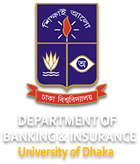Course objectives: This course is intended to cover all the dimensions of bank management ranging from deposit, asset-liability management, liquidity, credit, investment to equity management. While studying, the students are expected to understand different categories of services offered by a commercial bank, measure and evaluate the performance of a commercial bank, find the interest sensitive GAP and its impact over the asset portfolio of the bank, understand different money market and capital market instruments that are used as vehicle for investment, ways to manage the liquidity and reserve of a commercial bank, and set and evaluate strategies to pricing a bank’s deposits and loans.
Course content: Overview of the changing financial services industry, impact of government policy and regulation on industry, organization and structure of the industry, measuring and evaluating the performance of banks; risk management for changing interest rates: ALM and duration gap; investment function in financial services management, money and capital markets instruments, liquidity and reserve management strategies and policies, managing and pricing deposit, management of capital and capital adequacy, state of Basel I, II and III implementation; lending policies and procedures: managing credit risk; lending to business firms and pricing business loans, bank collateral management.
Textbook: Bank Management and Financial Services by Peter S. Rose andSylvia C. Hudgins
Reference books
1. Management of Financial Institutions by Anthony Saunders
2. Investments by ZviBodie, Alex Cane andAlan J. Marcus
Course objectives: The objective of this course is to provide the basic concepts of foreign exchange while highlighting the recent changes in foreign exchange and foreign trade that give rise to different new areas to explore. After completion of this course, students are expected to understand the needs and functions of foreign exchange markets and international financial markets along with multifarious work management in foreign exchange branches of commercial banks.
Course contents: Foreign exchange and international financial system, architecture of foreign exchange markets, participants in foreign exchange markets (arbitrage, speculation, hedging), exchange rate determination, types of foreign exchange operations (spot, forward, FX swaps, currency swaps, futures and option) and documentation, relationship between the changes of exchange rates and the dynamics of fundamental economic factors (balance of payments, inflation, interest rates, expectations), nature of foreign exchange exposure and risk and its management, structure of the balance of payments and main relations between economic transaction in the balance of payments, export and import financing, international investment and capital flow, foreign exchange scenario in Bangladesh.
Textbooks
1. Foreign Exchange and Risk Management by Syed Ashraf Ali
2. International Financial Management by Jeff Madura
Reference book: Money, Interest and Banking in Economic Development by Fry J. Maxwell
Course objectives: This course is the application of modern finance theory to the financial decision making and management of banks and non-bank financial institutions particularly from a risk perspective. After completing this course students will understand the risks such as interests rate risk, credit risk, market risk, liquidity risk, operational risk etc. confronted by financial institutions. Students will also be able to apply relevant techniques to measure and manage them.
Course contents: Financial services industry, specialness of FIs and financial intermediation risk, off-balance-sheet risk, interest rate risk-I and II, credit risk-I and II, sovereign risk and foreign exchange risk, liquidity risk, liability and liquidity management, operational risks management, capital adequacy.
Textbook: Fundamentals of Financial Institutions Management by M. Cornett and A. Saunders
Reference book: Bank Management and Financial Services by Peter S. Rose and Sylvia C. Hudgins
Course objectives: The course aims to provide students with a holistic macro view of finance and banking sector, especially how the environment might be shaped and influenced by policies and regulations from government and regulatory agencies, and foundation knowledge in bank management.
Course contents: Meaning and importance of financial regulation and supervision, framework for banking regulation and supervision, banking acts, supervision of bank liquidity and capital adequacy (Basel Accord), control on foreign currency exposure, changing structure of banking regulations, supervision and regulation of investment business, supervision and regulations of insurance business, regulations overseas, causes of regulatory changes.
Textbooks
1. The Economics of Money, Banking and Financial Markets by FredericS.Mishkin
2. An Introduction to Global Financial Markets by S.ValdezandP.Molyneux
Reference books
1. Inside the City –How the Money Machine Works by P. Coggan
2. Relevant practical cases, required newspaper cuts and chapters of referred books
Course objectives: The main objectives of the course are to introduce students to econometric techniques and to prepare them to do their own applied work. Students are encouraged to think of the course as a preparation toward their thesis research project. The prerequisites of the course are Calculus and Statistics at an intermediate level. The knowledge of some computer-programming will be necessary.
Course contents: Concept of econometrics, simple regression model, multivariate regression analysis, inference in the multivariate regression model, asymptotic properties of OLS, further issues in OLS estimation, heteroskedasticity, introduction to panel data methods, application/lab practice.
Textbook: Introductory Econometrics: A Modern Approach by Jeffrey Wooldridge
Reference books
1. Econometrics Methods by J. Johnston and J. Prischke
2. Econometric Analysis of Cross Section and Panel Data by Jeffrey Wooldridge
3. Econometric Analysis by W. H.Green
